
views
X
Research source
Creating a Habitat for a Soft Shelled Turtle
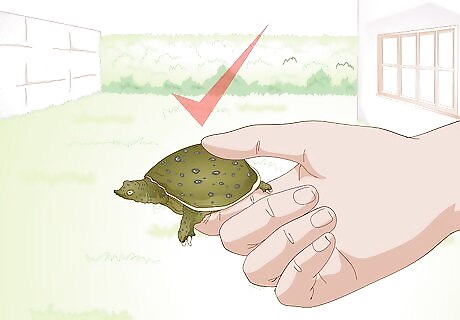
Decide which animals will live in your tank. Because soft shelled turtles can be aggressive, you should not put them in tanks with other turtles or animals. Sometimes they can live in pairs, but only with enough space and minimal bullying. It is probably best to have just one softshell turtle living in the tank.

Find a large tank. Allow 5 to 10 gallons of tank for every inch of carapace (shell) length of your turtle. However, no tank is too large for a soft shelled turtle. They are active swimmers. Keep in mind how large your turtle could grow in the future. Look up the particular breed of soft shelled turtle you have or plan on getting and see how large it could potentially get. Buy a tank that will accommodate your turtle even in his later years. Many experienced turtle owners suggest getting at least a 20 gallon tank for babies and a 40 gallon tank for adults.
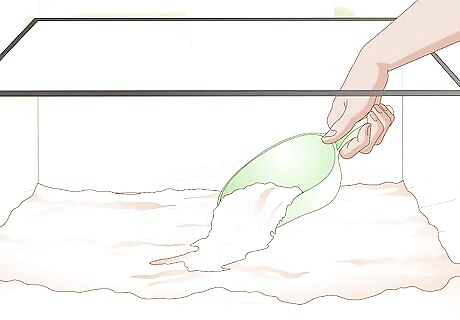
Add a sand substrate. Add a layer of river sand to the bottom of your tank. There should be enough sand such that your soft shelled turtle can immerse himself completely. The sand should be free of rocks or any objects that could scratch your turtle’s shell and cause an infection. You can buy sand at an aquarium store. It should be very high quality sand, because these turtles frequently burrow themselves in the sand. Ask a person at your pet store if you need to clean the particular type of sand before you put it in the tank.
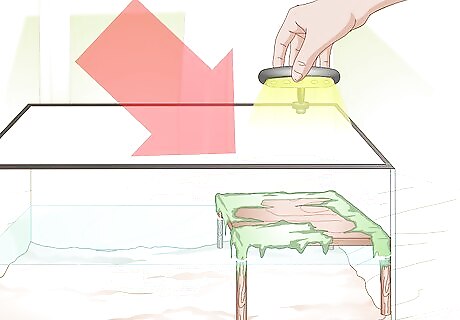
Add a place for your turtle to bask. Place both natural and manmade structures into the tank, leading up to the surface of and out of the water. Your turtle should have easy access to an area where he can lie completely out of the water and under a heat lamp. Place the basking area accordingly, so that there is enough room for your turtle to lie completely out of the water. Make sure that your surfaces are not sharp and that they make it very easy for your turtle to get out of the water. You can have many successful types of basking areas. You can buy specific basking ramps or platforms at an aquarium store. These would be a safe choice for your turtle. You could also purchase a rock or a log to put in your aquarium, once your turtle is more acclimated to the tank. Just make sure that the surface is smooth and will not scratch your turtle as he climbs onto it. Basking is necessary for your turtle’s health. Make sure that his basking space is inviting and easily accessible! Put your basking area on a really gentle incline, so that your turtle has a really easy time climbing up to bask. Watch your turtle for extended periods of time, checking in on him frequently, to ensure that he’s actually using the basking space. If he’s not, he could develop a host of medical issues.
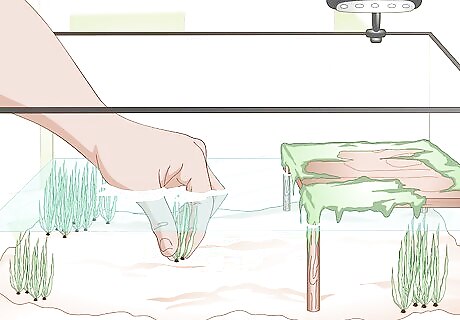
Add live plants. Live plants are also very important in your tank. They will help oxygenate your water and give your turtle a little more scenery. The amount of plants you have will vary greatly on the size of your tank, but you should make sure that you do not have so many plants that the turtle cannot burrow under the sand. In other words, make sure that there are plants to oxygenate the water, but do not crowd them on the floor of the tank. Soft shelled turtles might dig up the plants when they are trying to burrow. Plant live plants around the edges of the aquarium, and put soft, smooth rocks around them to prevent this uprooting. Try a Java Fern or a plant from the anubias family. Choose a plant that is hardy and does not mind being replanted.
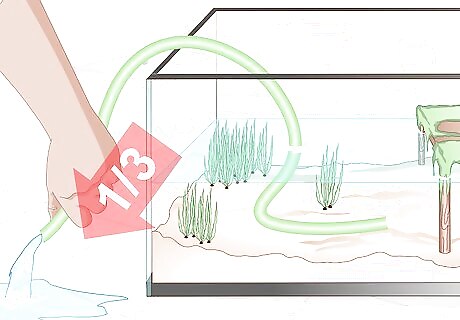
Change a third of the water once per week. Take out a third of the water in the tank and dispose of it. Treat the new water with a dechlorinating agent before you put it into the tank. Put the water into the tank slowly, being careful not to disturb the turtle or the plants too much. Changing out the water regularly (in addition to using a filter) is super important to keep your turtle healthy.
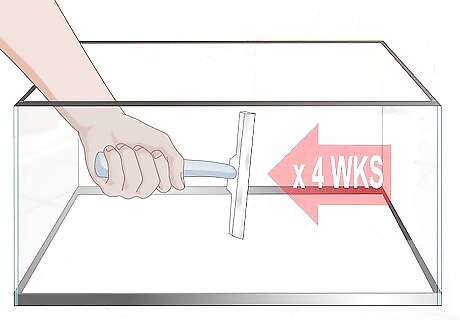
Clean the whole tank once every 2 to 4 weeks. You can vary this depending on the size of your tank and effectiveness of your filtration, but 2 to 4 weeks is a good estimate. While you clean your tank, put your turtle in a smaller container with some of the old water in it. Replace the sand substrate completely. Take out all tank furnishings (everything but plants and sand). Make a solution that is one part bleach to 20 parts water, and scrub these furnishings with this solution and a toothbrush.
Providing Clean Water for a Soft Shelled Turtle
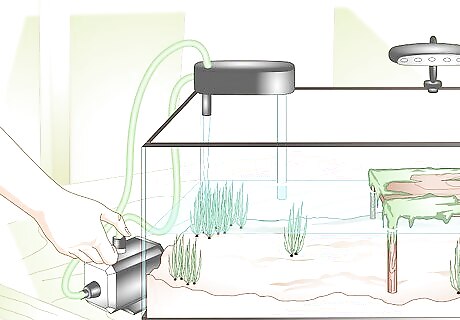
Buy proper filtration. Proper filtration is extremely important for soft shelled turtles because they can get infections very easily. Consider buying the more expensive (but more effective and easier to clean) external pumps, rather than ones that are submersible inside the tanks. They are more expensive but worth it because you will get a higher quality filtration and an easier cleaning process.
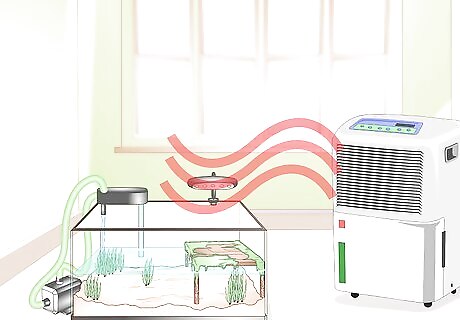
Ensure the correct air temperature. The air in your turtle’s room should be between 75 and 80 degrees Fahrenheit. If you live in a warm climate, you could potentially keep your turtle outside, but more likely you want to keep your turtle in a room in your house that you can heat or cool to this temperature all the time.
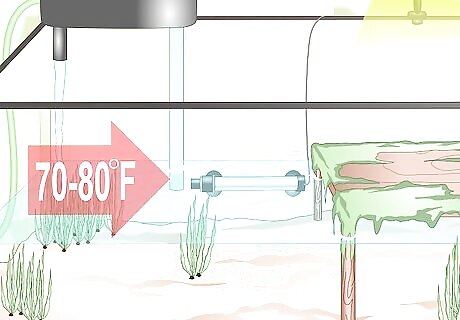
Ensure the correct water temperature. The water temperature should be only a little bit colder than the air, between 70 and 80 degrees Fahrenheit. You may need to purchase a water heater for the water in your tank. Titanium heaters are suggested because they are more difficult to break if your turtle swims around a lot. Keep a thermometer in the water to ensure that the temperature remains between these temperatures.
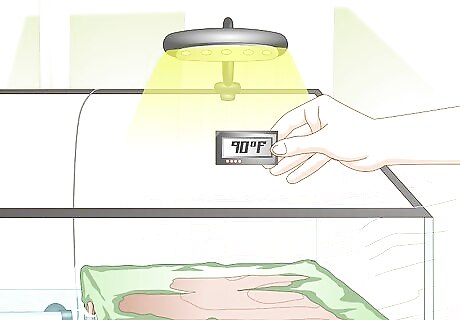
Ensure the correct temperature in the basking area. The basking area is the area completely out of the water where your turtle will leave the water to dry out and enjoy the heat of the heat lamp you provide. This area should be between 90 and 100 degrees Fahrenheit. Put a thermometer in the basking area to make sure that the temperature is suitable.
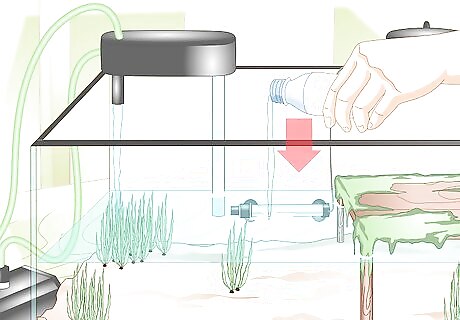
Add chemicals to the water, if needed. Go to your local pet store and find water conditioner that is suitable for turtles. The water that your turtle should live in will be free of chlorine, so find a water conditioner that dechlorinates water. Your water should also be slightly acidic and oxygenated. To make the water more acidic, first buy a pH testing kit and test your tank’s current pH level. Your tank should only be slightly acidic, so somewhere between 6.0 and 6.5. Once you’ve tested your tank, determine if you need to make the water more acidic or more basic. From there, buy the correct kit (either for making your water more acidic or more basic) and follow the instructions on the package from there. Then, test your water again.
Maintaining the Health of Your Soft Shelled Turtle
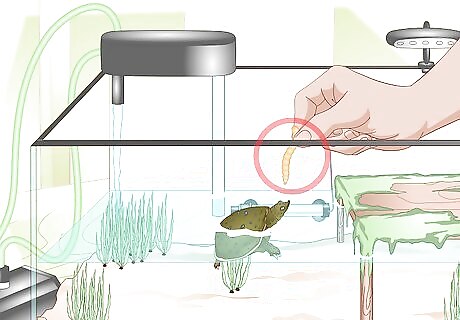
Feed your soft shelled turtle live bait. Begin by feeding your turtle exclusively live bait. You can, however, give him some catfish food or commercial reptile food after he is accustomed to his surroundings. You should sprinkle calcium supplement on all of the food you give your turtle. You should also give your turtle a multivitamin if he does not have a specially curated turtle-specific diet or eat live fish. How often you feed your turtle depends on your turtle's breed, size, and age. Ask your veterinarian for advice on how often to feed your turtle. Here’s a list of the different types of food that you can feed your soft shelled turtle: Small fish (but not catfish or carp) Worms Crickets Crayfish Shrimp Commercial diets Tadpoles Mudpuppies Snails Molluscs Dog food Cooked chicken
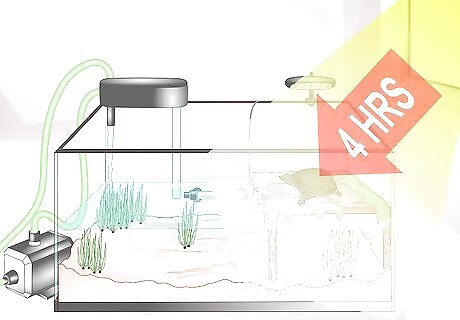
Expose your turtle to enough daily sunlight. Even if you have UV lights for your turtle, you should give your turtle between 2 and 4 hours of direct sunlight every day. Place your turtle’s tank near a window that gets about this much sunlight.

Get your turtle’s beak clipped regularly by a veterinary professional. Occasionally, soft shelled turtles’ beaks will overgrow. Go to your veterinarian to have his beak clipped. Ask your veterinarian at what point and how often your particular turtle should get his beak clipped.
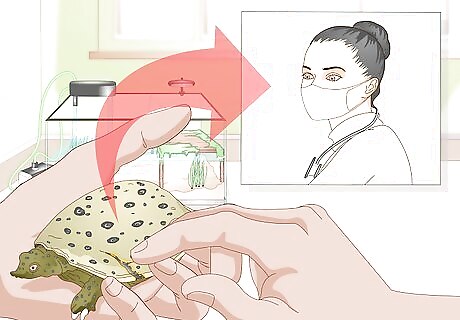
Watch for signs of illness. Soft shelled turtles are delicate and can develop a lot of medical problems. Look out for any of these signs. If you see any of these symptoms, bring your turtle to the vet for further care. Infected lacerations on the skin or shell Discoloration of the skin or shell Raspy breath or wheezing Swollen limbs Fungus General unresponsiveness Closed or swollen eyes Loss of appetite Runny nose and eyes Look online for common health problems in your specific breed of turtle. Different types of soft shelled turtles can develop some different health issues.




















Comments
0 comment